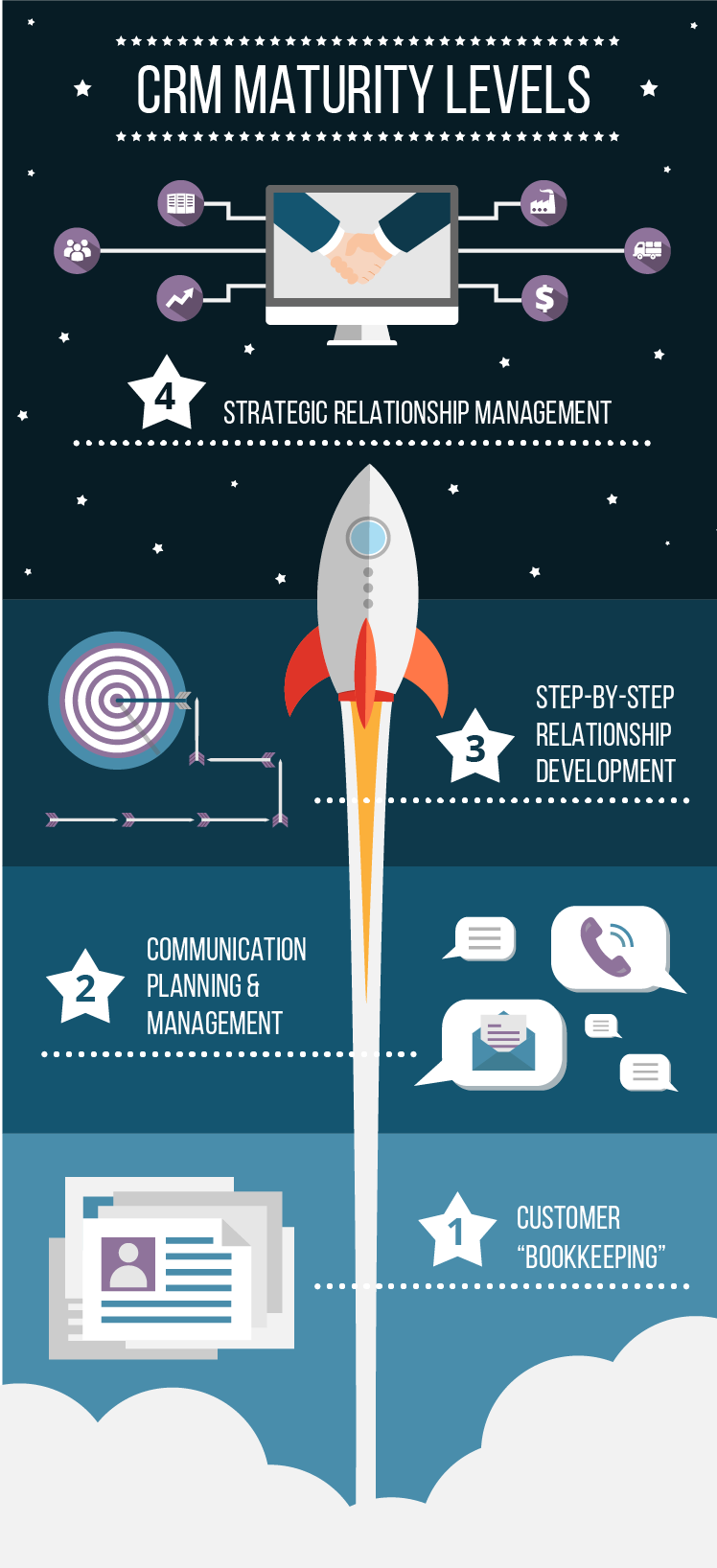4 Levels of CRM maturity model
Deploying a CRM system is just like launching a spaceship into the outer space. While advancing, you will need ever more resources to break from the gravitational forces and get to the point of maximum impact from your activities. Here, our CRM consultants will look at 4 stages of the CRM maturity model ascent to define where an enterprise can take this ‘spaceship’ from its current coordinates.

1. Troposphere: customer bookkeeping
The voyage has just begun, and all you have is your CRM software that was deployed enterprise-wide. You use it to keep a nice database of your clients, to view the history of your communication (retroactively), and to register your outbound sales activities that are, however, not aligned with or measured against your specified sales objectives. When needed, you can even discover old contacts, such as partners and advertisers, or track organizational connections between your leads.
At this stage, having a CRM solution is frequently confused with having an actionable and measurable CRM strategy in its own right. The system is still focused on the past and the present of your customer relationships with no data-driven foresights into the future.
Sadly, the majority of companies get stuck exactly at this maturity (or rather immaturity) level in their CRM journey.
2. Mesosphere: communication planning & management
You’ve made a big leap in your approach to CRM. Now, you make your first steps towards forward-thinking and a clearly defined CRM strategy, which requires more administrative resources.
This stage sees the low-key beginnings of analytics that you may use in planning and managing communication to nurture and keep up with your leads and customers. You activate handy CRM alerts and notifications to assist you along the way and probably tweak your system to provide a consolidated view of all the contact interactions.
3. Termosphere: step-by-step relationship development
At this stage, you learn to develop your customer relationships, not just passively respond to them. This sea change in your attitude to CRM implies that you start stimulating customer conversion not only through lead nurturing but through assigning individual milestones for targeted leads and customers (personal meetings, pilot projects, etc.) for your sales reps to achieve in order to encourage positive movement through the sales pipeline.
This approach should involve integrated efforts across your organization and can probably result in introducing sales productivity goals to effectively manage step-by-step relationship development.
4. Outer space: strategic relationship management
In the world of CRM, the outer space feels extremely lonely – only a fraction (less than 3% according to our estimates) of all companies that adopt the technology make it to this stage. But those that do surely know how to multiply sales to strategic customers.
This particular stage contains no lead-focused activities, as strategic relationship management is all about your most valuable (including prospective value) customers. At this maturity level, you are likely to measure the current and future value of customers to determine the amount of resources you are ready to invest in retaining strategic accounts. This stage requires leveraging your upselling and cross-selling potential to win a bigger share of your clients’ budgets in the limited market by becoming their preferred supplier. Imagine, one of your top customers considers a dedicated delivery center on another continent. This is an opportunity for you, but how do you prioritize between dozens of such opportunities? And how do you know these opportunities are still up a month later?
At this stage, CRM becomes a part of a company’s mindset, and a respectively customized CRM solution turns into a key tool that enables advanced and truly impactful campaigns to retain top clients.
Conclusion
The upward movement is always a matter of resources and determination, but the CRM logic is simple – the maximum impact can only be achieved at the highest stages of your CRM evolution. Any investments that don’t result in bringing your enterprise up at least to the second maturity level are highly questionable, whereas each next stage has a potentially greater capacity to bring higher ROI from your sales activities and optimize revenues from the customer base. To learn more about profit generation with a CRM, read our previous blog post.

